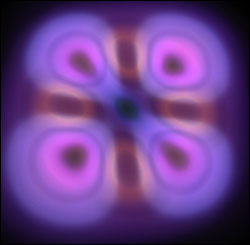
Purdue Gets Nano Grant
WEST LAFAYETTE, Ind., Sept. 20, 2007 -- Purdue University's Network for Computational Nanotechnology has received a five-year, $18.25 million grant from the National Science Foundation (NSF) to support the US National Nanotechnology Initiative with expanded capabilities and services for computer simulations, NSF and Purdue officials announced today.
The national network was launched in 2002 with $10.5 million from NSF to develop sophisticated, high-powered computational tools that allow scientists from Boston to Beijing to advance nano-related research simply by using their desktop computers.
"This additional funding will help us expand these sophisticated computational tools to researchers, educators and even industry," said network director Mark Lundstrom, a Purdue electrical and computer engineering professor. "With the help of our five partner universities, we are growing beyond our roots in nanoelectronics to new areas such as nanofluidics, nanomedicine, nanophotonics and applications of nanoscience to the environment, energy, the life sciences and homeland security."

An image of a quantum dot produced by a simulation using the nanoHUB, a Web site created by the Purdue-based Network for Computational Nanotechnology. The site features research simulations on topics such as carbon nanotubes, nanotransistors, nanoelectronics and quantum dots. This image shows the computed second excited electron state of a quantum dot nanodevice in which electrons resonate and emit pure bright light. Quantum dots are the basis of the new, energy-efficient, long-lasting, ultrabright LEDs that are becoming widely used in highway traffic signals. (Image courtesy Purdue University)
The project is based in Purdue's Discovery Park and includes partners at the University of California at Berkeley, the Molecular Foundry at Lawrence Berkeley National Laboratory, University of Illinois at Urbana-Champaign, Norfolk State University, Northwestern University and the University of Texas at El Paso.
Mihail Roco, NSF senior adviser for nanotechnology, said the project shows that the NSF is committed to working with the US educational system and research institutions to ensure this nation fulfills the promise of nanotechnology and that its societal benefits are broadly and equitably distributed.
"The Network for Computational Nanotechnology at Purdue has become a leading knowledge open-source organization in the world, with a focus on nanoscale understanding, predictive simulations and education. It is an 'integrator' of disciplines, experts, networking capabilities, and areas of application around the same nanoscale principles and tools," Roco said.
He said the network also aims to be a model for creating simulations that go well beyond the field of nanotechnology and that it "has reached out to other universities to build experimental tools that have become the benchmark for equipping researchers committed to advancing emerging nano-info-bio technologies."
The face for this global network is the nanoHUB (www.nanohub.org), a free, Internet-based science gateway used by more than 3000 national and international researchers and educators every month. In addition to online simulation services, the site's menu includes courses, tutorials, seminars, podcasts, user reviews of tools and content, and discussions on the topics of nanoelectronics, nanomedicine and nanomaterials, as well as facilities for global collaboration.
Use of the Web site has increased fivefold the past two years, pushing current traffic to more than 25,000 users. In the last 12 months, 5700 users have run more than 220,000 simulations with 50 available simulation tools, Purdue said in a statement. Another 80 non-network affiliated researchers have cited the nanoHUB in their publications.
These simulations describe the tiniest, nearly atomic-scale building blocks of nanodevices as well as components that are visible to the naked eye. At the same time, these multiscale simulations are key to using nanotechnology research to design diagnostic devices for medicine, sensors for homeland security, environmental monitoring and other potential applications.
Tthe site gives scientists and students access to resources that they would otherwise have to install and deploy themselves on their personal computers, said Gerhard Klimeck, a Purdue professor of electrical and computing engineering who leads the nanoHUB project.
"Beyond just accessibility, true usability of simulation tools and tutorials by nonspecialists and our ability to deploy many tools rapidly have been the key elements to success," Klimeck said. "Our 'hub' is different from other portal technologies, which typically require significant rewrites of the science software for Web deployment. We can host sophisticated simulation engines on the Web as-is or develop powerful new interfaces in just days with our Rappture toolkit."
Current popula topics on the site include carbon nanotubes, nanotransistors, nanoelectronics and quantum dots. And Lundstrom and Klimeck say gateways focused on other disciplines, such as pharmacy, cancer and medical research, will be launched in the near future using the same technology.
For more information, visit: www.purdue.edu
Published: September 2007